July 31, 2017
Aiming to Build New Communities in Earthquake-Stricken Areas: Ishinomaki Jichiren's Initiatives
Keywords: Civil Society / Local Issues Disaster Reconstruction Newsletter
JFS Newsletter No.179 (July 2017)
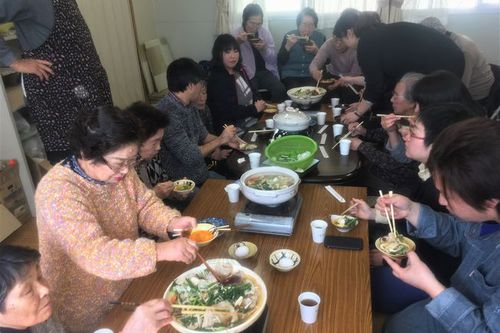
Copyright The Third Stage All Rights Reserved.
Six years have passed since the Great East Japan Earthquake of March 11, 2011. The interest in and support to areas in Tohoku Region that were heavily damaged by the earthquake are said to be gradually dying down. Part of the reason is that the Kumamoto earthquakes last year also caused great damage. Yet, despite the passage of time, the Tohoku disaster areas have yet to recover.
Early in July, we visited Ishinomaki, Miyagi Prefecture, for a direct view of the current situation and efforts six years after the earthquake. Ishinomaki, with an area of 555 square kilometers, has the second largest population in Miyagi Prefecture, next to Sendai. The Port of Ishinomaki, one of the best fishing ports in the Orient, lends the city an air of vigor with many sightseeing spots, and also provides it an active role in agriculture.
On March 11, 2011, a great earthquake with a seismic intensity of over 6 on the Japanese scale of 7 hit Ishinomaki, with a subsequent tsunami, reaching over 10 meters in height in some places. More than 3,200 deaths were directly attributable to the earthquake and tsunami, rising to more than 3,550 when other disaster-related deaths are included. More than 420 people are still missing. More than 20,000 houses or buildings were completely destroyed, with more than 13,000 half-destroyed and more than 23,000 partly destroyed. Extensive areas of the city were flooded by the tsunami. Archives have been released with many photographs documenting the disaster to record the state of disaster and progress toward recovery in Ishinomaki. (Follow the website link below.)
http://www.city.ishinomaki.lg.jp/cont/10151000/1501/24-31.pdf (Japanese only)
The disaster victims initially stayed in shelters set up at elementary and junior high schools, temples and other facilities open to the public. After that, some, such as those who had lost their homes, moved into temporary homes built in various parts in the city. Previously, when we visited some of the temporary housing complexes, many were single-story prefabricated buildings, which gave the residents many opportunities to meet each other, and since many volunteers often visited, it seemed to us that a sense of community had been established at many of the temporary housing complexes.
However, now that several years have passed since the earthquake and the number of people moving out of the temporary housing complexes is increasing, closing and consolidation of temporary housing is underway and post-disaster public housing, where disaster victims can live long term, is being built across the city. Post-disaster public housing is public rental housing for those who have lost their houses due to the disaster and cannot rebuild their houses by themselves.
The temporary housing complexes were single-story, providing a sense of proximity among the residents, while post-disaster housing consists mostly of two-story, three-story or four-story reinforced-concrete apartment complexes. Some of them are even ten-story buildings like high-rise condominiums. Although there are assembly rooms and other gathering places in such apartment complexes, chances to connect and interact with other residents are lost once the iron front doors to their apartments are closed. Furthermore, since disaster victims are moving into post-disaster housing from different areas, they lack past connections and shared history in the areas where they lived before the earthquake.
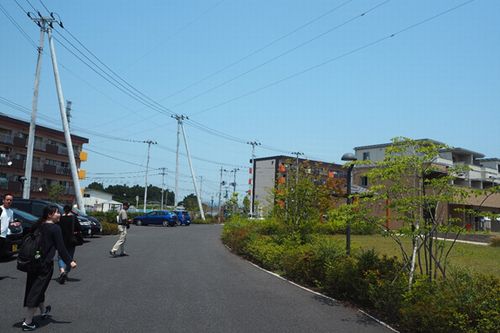
In this context, we visited Ishinomaki Jichiren, a general incorporated association (legally-registered society in Japan) that is making efforts to build resident communities in post-disaster housing. There we interviewed Kei Masuda, the association's chairman, and Toru Utsumi, its secretary-general. In this issue of the JFS Newsletter, we introduce our interview with these two people.
Introducing the Organization
The forerunner of Ishinomaki Jichiren was the Ishinomaki Post-Disaster Housing Residents' Association Union Promotion Organization, which was established on December 9, 2011. At that time, Ishinomaki had 134 temporary housing complexes. Five of those had residents' associations. Their officials gathered to establish this union organization under the slogan of "Let's prevent kodokushi (lonely deaths)."
At first only residents participated in our meetings to discuss issues, but the next year in February we invited staff members from the municipal government and a local social welfare council. Now the participants include doctors from municipal hospitals, officers from the Community Safety Division and the Community Police Affairs Division of the local police station and staff members of the Fire Prevention Division of the local fire station.
The number of member households was 3,338 in 42 different housing complexes at its peak, accounting for 54.2 percent of all residents living in temporary housing for disaster victims in the city. Our organization now solicits and compiles the opinions of disaster victims living in the city and we believe that through this activity, a "win-win" relationship is established between disaster-victim residents and the local government.
After we continued various activities for four to five years, some said that maybe it was about time for us to wrap up our activities, thinking our mission would be completed when the temporary housing complexes for disaster victims were closed. On the other hand, we started to receive many comments from people who had moved to post-disaster public housing complexes asking for our help, saying "We were happy right after moving into our new place, but now we feel lonely here."
Post-disaster public housing complex buildings are solid and secure, protecting tenants' privacy. On the other hand, however, it makes it quite hard to build a community there. Someone suggested establishing a corporation for continuing activities, so our organization became a general incorporated association named "Ishinomaki Jichiren" on January 19, 2016. All funding for our activities is covered by subsidies from the prefectural and municipal governments and corporate foundations.
Activities
Executive members of each residents' association hold a monthly chapter meeting, where they bring up various issues to discuss. Particular problems which cannot be solved at a chapter meeting will be brought up at an Ishinomaki Jichiren board meeting. Public meetings, to which officers of the local police and fire stations are invited, are organized as needed to solicit ideas for solving these problems. After each board meeting, a quarterly newsletter is issued and posted on the bulletin boards at post-disaster public housing complexes.
Ishinomaki Jichiren also serves as a liaison to other people. There are about 40 cases a year where cooperation and coordination are needed for handling interview requests or offers of support from individuals, local governments, academic organizations, companies, etc. Many people visit Ishinomaki to learn about disaster prevention, including local government officials in the Tokyo metropolitan area and Shizuoka Prefecture, where a major disaster is thought possible in the near future, and in Kumamoto Prefecture, which is undergoing reconstruction after a big earthquake last year. Even delegates from overseas come here for the same purpose. Our organization also distributes food and other relief items sent from people around the country to local residents.
Many volunteers also come to Ishinomaki. Various events are organized at each temporary housing complex, but we are trying to create opportunities to link people in temporary housing and post-disaster public housing complexes. To that end, we organize Karaoke competitions, sports events, one-day hot spring bus tours and the like and invite residents in both kinds of housing complexes to participate.
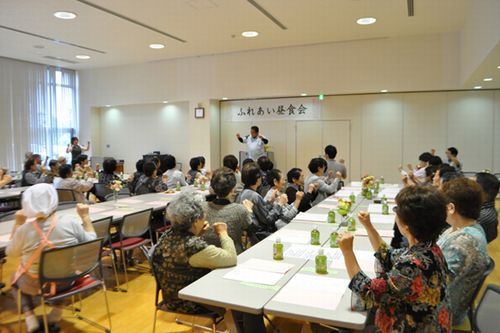
Copyright The Third Stage All Rights Reserved.
Building a community in post-disaster public housing is quite a challenge. In temporary housing complexes, you can make eye contact through the windows, as housing there consists of single-story buildings. If you feel like a walk and step outside, you will inevitably run into someone in the complex. On the other hand, in post-disaster public housing complexes, which are apartment buildings, you hardly see anyone when you step out of your apartment or even when you walk up and down the corridor. We have received comments such as, "There is this elderly guy, who sits at his door with it open and looks out at the corridor every day. Could you look in on people like him as well?" Therefore we engage in various initiatives to help residents build communities.
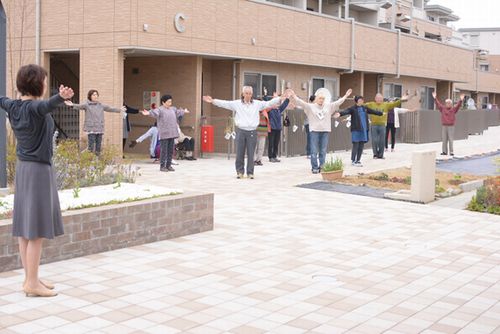
Copyright Ishinomaki Jichiren all rights reserved.
At post-disaster public housing complexes, some residents gather in the courtyard around 8:30 every morning to enjoy radio exercises together, and other residents have started to organize various kinds of club activities in the assembly halls. We just help get the ball rolling for those club activities and ask club members to make sure that they select one resident as a person in charge of their club. Now a wide variety of clubs are available, from artistic postcard painting and Japanese folk music to volunteer work, healthy mahjong lessons and so on.
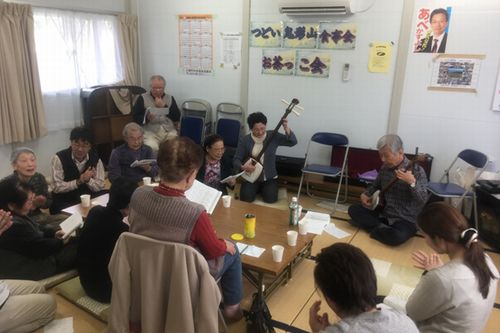
Copyright The Third Stage All Rights Reserved.
Since the mahjong lessons help prevent dementia, even men who tend to stay at home and rarely participate in other events have joined them. We also hold a series of study sessions on dementia, because this illness is also a challenging issue in our aging society. Based on the study sessions, a group that offers monitoring and support for people with dementia, called "Tsunagari (meaning "connection") Supporter Pal," was established and conducts activities every month.
Ishinomaki Jichiren established a Tsunagari Card, on the back of which its holder writes his/her contact information in case of an emergency. The card is about the size of a business card when folded in half, easy to carry. On the back, there are also sections for contact information not only of their family members but also their neighbors, so that they can exchange their contact information with others in the neighborhood. In this way, we help them communicate with each other on a regular basis.
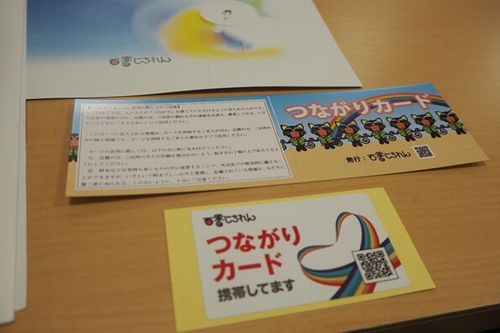
In June 2016, Ishinomaki announced a new program to promote reconstruction and self-sustenance among the city's disaster victims. In this project, the then-existing 132 temporary housing complexes are to be consolidated into 22 within 12 to 18 months. We realized that we needed to create a platform for interaction between previously settled and new residents. To accomplish that, we started holding tea parties every week at 10 housing complexes at a fixed time and venue. If new residents go to one of the established venues during the designated time, they will be able to talk with someone there. Since we obtained grants from the prefecture, we are thinking of increasing the number of the complexes with this kind of tea party from 10 to 17.
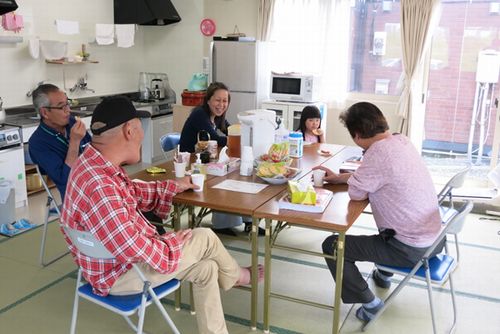
Copyright Ishinomaki Jichiren all rights reserved.
These activities have received high recognition, and in fiscal 2016 we were selected by the Reconstruction Agency of Japan for their award in the reconstruction achievement category of the "New Tohoku" project.
We have heard that Japan will continue to allocate a budget for reconstruction for at least another four years. Even so, we are not sure if our activities will be chosen for national grants. Nor will the nation continue to offer grants for reconstruction forever. We must continue our activities in a sustainable manner, but how can we get the financial resources to support them? This is a tough issue, but we must consider it.
Living in a new place must be a source of anxiety to many people, and all the more so to disaster victims, who are under severe stress and face uncertainty in many ways. In this situation, Ishinomaki Jichiren is playing a significant role in creating and supporting communication platforms for these residents.
The people we met in Ishinomaki, including people working for Ishinomaki Jichiren and those affected by the disaster, repeatedly expressed gratitude to the volunteers and supporters. When the organization heard the Philippines had been hit by a typhoon and sustained damage, it called for donations and collected some 500,000 yen (US$4,505). More recently, the organization sent donations of around 280,000 yen (US$2,545) to areas affected by the 2016 Kumamoto Earthquakes.
Japan is an earthquake-prone country. In addition, the incidence of disasters caused by torrential rain and so on has been increasing, partly due to the impacts of global warming. Our visit to Ishinomaki, made us keenly aware that anyone could become a disaster victim tomorrow; people affected by the disaster are making persistent voluntary efforts to develop a community under the tough conditions caused by the disaster; and such efforts are important. Even though time has passed, this is something we must never forget. This is the message from Ishinomaki that we want to send to everyone around the world.
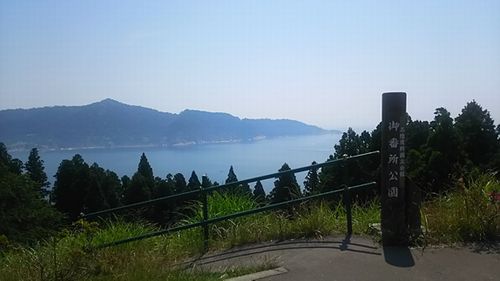
Written by Yuka Kume and Junko Edahiro
Related
"JFS Newsletter"
- 'Good Companies in Japan' (Article No.4): 'Eightfold Satisfaction' Management for Everyone's Happiness
- "Nai-Mono-Wa-Nai": Ama Town's Concept of Sufficiency and Message to the World
- 'Yumekaze' Wind Turbine Project Connects Metro Consumers and Regional Producers: Seikatsu Club Consumers' Co-operative
- Shaping Japan's Energy toward 2050 Participating in the Round Table for Studying Energy Situations
- 'Good Companies in Japan' (Article No.3): Seeking Ways to Develop Societal Contribution along with Core Businesses


